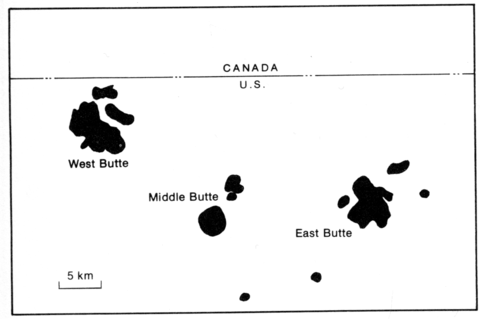stripes
Lying just south of the Canadian border the Sweet Grass Hills comprise three buttes, East, West and Middle, around which Cretaceous and Jurassic sediments are domed and cut by igneous intrusions. The main igneous bodies are believed to be laccolithic but numerous sills are also present, particularly on the Middle and East Buttes, together with a number of dykes. The rocks are generally porphyritic and highly variable in colour index. They range from gabbroic varieties with biotite and an amphibole to syenites with quartz, or nepheline and analcime, and aegirine-augite. The sills and dykes are very variable in petrography and include amphibole trachytes and varieties with pyroxenes zoned to aegirine rims and abundant biotite. Minettes are widespread and composed of biotite phenocrysts in a groundmass of pale green pyroxene, orthoclase, magnetite, apatite and carbonate. Numerous inclusions of Precambrian rocks are found in some sills. Palaeomagnetic data are available in Diehl et al. (1983). Dykes related to these localities occur to the north in Alberta, Canada (see Canada No. 40).
DIEHL, J.F., BECK, M.E., BESKE-DIEHL, S., JACOBSON, D. and HEARN, B.C. 1983. Paleomagnetism of the late Cretaceous-early Tertiary north-central Montana alkalic province. Journal of Geophysical Research, 88: 10593-609.
HEARN, B.C., MARVIN, R.F., ZARTMAN, R.E. and NAESER, C.W. 1978. Ages of alkalic igneous activity in north-central Montana. Professional Paper, United States Geological Survey, 1100: 60.
KEMP, J.F. and BILLINGSLEY, P. 1921. Sweet Grass Hills, Montana. Bulletin of the Geological Society of America, 32: 437-78

